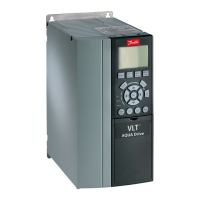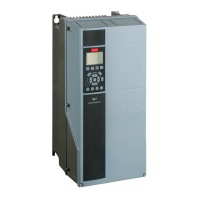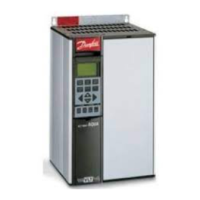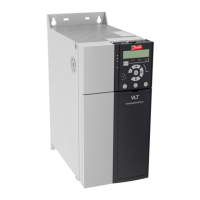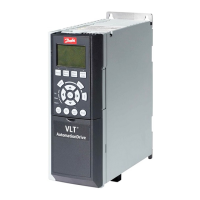20-81 PID Normal/Inverse Control
Option: Function:
[0] * Normal
[1] Inverse
Normal
[0] causes the frequency converter’s output frequency to decrease when the feedback is
greater than the setpoint reference. This is common for pressure-controlled supply fan and pump
applications.
Inverse
[1] causes the frequency converter’s output frequency to increase when the feedback is
greater than the setpoint reference.
20-82 PID Start Speed [RPM]
Range: Function:
Application
dependent*
[Application dependant] When the frequency converter is first started, it initially ramps up to this output speed in Open Loop
Mode, following the active Ramp Up Time. When the output speed programmed here is reached,
the frequency converter will automatically switch to Closed Loop Mode and the PID Controller will
begin to function. This is useful in applications in which the driven load must first quickly accelerate
to a minimum speed when it is started.
NB!
This parameter will only be visible if par. 0-02
Motor Speed Unit
is set to [0], RPM.
20-93 PID Proportional Gain
Range: Function:
0.50 N/A* [0.00 - 10.00 N/A]
If (Error x Gain) jumps with a value equal to what is set in par. 20-14
Maximum Reference/Feedb.
the PID controller will try to change the output speed
equal to what is set in par. 4-13
Motor Speed High Limit [RPM]
/ par. 4-14
Motor Speed High Limit [Hz]
but in practice of course limited by this setting.
The proportional band (error causing output to change from 0-100%) can be calculated by means of the formula:
(
1
Proportional
Gain
)
×
(
Max
Reference
)
NB!
Always set the desired for par. 20-14
Maximum Reference/Feedb.
before setting the values for the PID controller in par. group 20-9*.
20-94 PID Integral Time
Range: Function:
20.00 s* [0.01 - 10000.00 s] Over time, the integrator accumulates a contribution to the output from the PID controller as long
as there is a deviation between the Reference/Setpoint and feedback signals. The contribution is
proportional to the size of the deviation. This ensures that the deviation (error) approaches zero.
Quick response on any deviation is obtained when the integral time is set to a low value. Setting it
too low, however, may cause the control to become unstable.
The value set, is the time needed for the integrator to add the same contribution as the proportional
part for a certain deviation.
If the value is set to 10,000, the controller will act as a pure proportional controller with a P-band
based on the value set in par. 20-93
PID Proportional Gain
. When no deviation is present, the output
from the proportional controller will be 0.
6.3.10 22-** Miscellaneous
This group contains parameters used for monitoring water/ wastewater applications.
VLT AQUA Low Harmonic Drive Operating In-
structions 6 How to Programme the Low Harmonic Drive
MG.20.T1.02 - VLT
®
is a registered Danfoss trademark 111
6
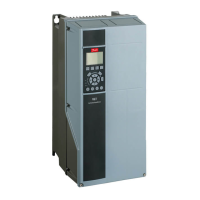
